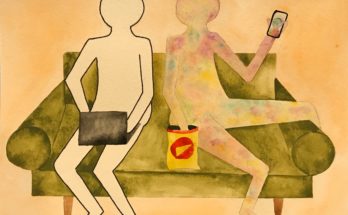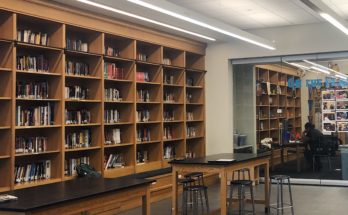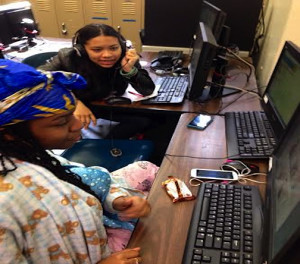
“Rosario, I can’t get my headphones to work again,” shouted Breana Heinds, a senior at East Side Community High School in Manhattan. It was 30 minutes into second period on pajama day for seniors at East Side High and Heinds was dressed comfortably in pink flannel pajamas, a royal blue turban and a white Teddy Bear bathrobe. Rosario Bellu, the teacher in charge of running East Side High’s foreign language computer lab rushed to help, replacing the headphones with new ones. Heinds placed the headphones over her ears and launched her Rosetta Stone Spanish lesson by logging into her account and beginning a lesson in pronunciation. She looked at a series of pictures and spoke into a microphone, repeating the objects’ names in Spanish. Once she had mastered the pronunciation of the words, the software allowed her to proceed.
East Side High is one of several schools in New York City that have adopted the Rosetta Stone software as their entire foreign language curriculum, replacing live instruction. Up until three years ago, students at East Side High could only take Spanish in a traditional classroom setting to earn the foreign language credits required by the New York Regents for graduation. Students in New York State must complete two years of foreign language instruction before the end of the ninth grade. In addition, two semester credits are required to earn a high school diploma and a credit sequence must be completed for an advanced diploma.

Three years ago, due to budget cuts, East Side High reassigned its certified Spanish teacher to a support staff position. A new dawn was upon East Side High, one that promised a cost-effective high-tech approach to foreign language education. Instead of receiving live instruction from a traditional certified language teacher, who wrote and delivered lessons, led class discussions, graded assignments and evaluated students’ individual performance based on the New York State syllabus, students now sit in front of a computer for 45 minutes a day, five days a week and engage in what Rosetta Stone calls Dynamic Immersion. This approach focuses on the memorization of words and phrases through images and sounds, much like infants acquire language.
A computer lab was devoted to the program. Three rows of black Dell desktop computers with headphones fill the room, a total of 26 individual stations. Progress reports for each student line the walls. They track the number of hours logged and the units covered over the course of the semester. Students advance at their own pace. Bellu was involved in the school’s purchase of the software four years ago. She said the cost for operating the program is approximately $5,000 per semester. “Some $15,000 a year because we include summer session,” she said. Because of Rosetta Stone, East Side High has been able to expand its course offerings. Students now choose from Spanish, Mandarin, French, German, Italian, Latin, Japanese, Korean, Portuguese, Vietnamese, Russian, Swedish and Polish. The overwhelming majority of students, 85 percent, choose Spanish. “Few students score below 90 percent on the program modules and quizzes,” said Bellu as she showed off the tracking feature, which provides statistics on individual student performance.
But the plan for foreign language education adopted at East Side High and other schools around the City may end up costing students far more than the schools are saving. Foreign language teachers, academics, unions, students and the Rosetta Stone company itself have become vocal opponents of using online programs to replace certified language teachers. They all agree that the software alone can’t replace live instruction in schools.
Missing Data
Foreign language instruction has been losing ground in the state for years. In 2010, the New York State Department of Education disbanded its Office of Languages Other Than English (LOTE) and made the department a subsidiary of the Office of Bilingual Education. Along with this major change, it eliminated the foreign language Regents exam. What this means is that student performance in foreign languages is no longer tracked through data as are core subjects like reading and math. “So no one is tracking the performance of students being taught solely through Rosetta Stone,“ said John Carino, the executive director of the New York State Association of Foreign Language Teachers, who has been teaching German in the Kenmore-Tonawanda School District outside Buffalo for 25 years. According to Bellu, currently the only students who are required to take the foreign language Regents exam are those seeking to test out of a foreign language course.
There are no official figures on how many foreign language teachers have been displaced by Rosetta Stone since the company began to market its program to schools in 2010. At the beginning of each school year, schools fill out a form to account for each certified teacher on its staff, Carino said. However, if a teacher has been replaced by a software program like Rosetta Stone, the school simply would not submit a form for that class. That means that school districts are not keeping a list of which teachers have been dismissed and replaced by Rosetta Stone. “We have no knowledge of any data out there indicating exactly how many teachers have been displaced,” said Irma Evangelista, president of the New York City Association of Foreign Language Teachers.
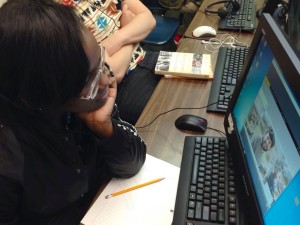
Starting in 2010, Rosetta Stone began an aggressive marketing campaign to penetrate public schools, said Martha Abbott, executive director of the American Council on the Teaching of Foreign Languages (ACTFL). She notes that in its campaign, Rosetta Stone claimed to be a cost-effective alternative to traditional foreign language instruction, promising schools great savings while maintaining educational outcomes for students.
“We became very concerned with this kind of aggressiveness in selling a product to principals claiming it could take the place of a qualified language teacher,” Abbott said. Last November, Abbott met with Rosetta Stone’s president, Steve Swad. The interview is featured in ACTFL’s website to educate principals looking to replace foreign language teachers with Roseta Stone, said Abbott.
In the interview Swad says that Rosetta Stone is not out to replace teachers. “Technology is a tool, not a substitute for classroom instruction,” he said. “We are no replacement for going through a complete classroom learning experience.” According to Swad, Rosetta Stone is a program designed to give teachers the tools to reinforce their core instruction. “We know that when Rosetta Stone is used in classrooms in a blended learning environment, it allows educators to provide more individualized attention and boost student success.”
Room 115
The Rosetta Stone computer lab sits in the basement of East Side High’s five-story brick building, in Room 115. Above the doorway leading to the lab is a Chinese proverb that reads: “Teachers open the door. You enter by yourself.” Yet perhaps when it comes to learning a foreign language at East Side High, no teachers are actually opening the door for students. Second period, which starts at 8:50 a.m., is Bellu’s first class. The informal atmosphere of the course is felt immediately upon entering the lab. No one calls Bellu by her last name. Most students call her Rosario. Others simply refer to her affectionately as Ro Ro. Bellu, who has been teaching since 2006, is certified to teach both math and special education. “I am not a language teacher,” she said throwing her arms up in the air and shrugging. Born in Italy, Bellu has been in the United States for over 15 years. She’s fluent in Italian and she speaks some basic French. “I have been desperately trying to learn Spanish, but I just don’t have the time,” she admits. She has been running the Rosetta Stone computer lab at East Side High School for two years now.
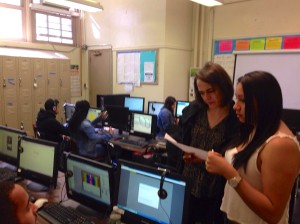
“This isn’t an ideal situation for students,” she said. “But some language education is better than none, right?” Each of the Rosetta Stone language courses is comprised of five levels; each level has eight units. In order to earn a grade of 100 in Bellu’s class, a student must complete two units per semester. The only actual assessment of a student’s learning comes from small quizzes that the software gives after each unit. “I let students go back and retake the quizzes until they have passed,” Bellu said, “so it’s really difficult not to do well in my course. If a student shows up and tries, that’s enough for me.” Bellu said that language courses at East Side High are not considered highly academic ones. “I think that using Rosetta Stone gives the student a very basic understanding of a language,” she said. “The program is basically designed to allow a tourist to engage in superficial conversations abroad. Students don’t really learn grammar rules and there is no exposure to culture.” The biggest limitation in the program, Bellu said, is her inability to assess students personally, because outside of Italian and French, she does not speak the languages taught. “I can’t really assess them beyond tracking their progress in the program,” she said.
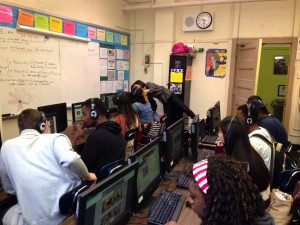
With new headphones, Heinds was busy at work with the program. She has been using the Rosetta Stone software to learn Spanish since last school year and is currently on Level 3. The high school senior, who is headed to Barnard College in the fall, said that Rosetta Stone has been a disappointment. “It’s just repetition,” she said. “It’s not even engaging. You are just forever repeating what’s on the screen.” Heinds would prefer having a language teacher leading the class. “I don’t really feel like I’m learning much other than the words I’m repeating,” she said. “I could never have an actual conversation in Spanish.”
And experts in language instruction agree. They worry that students may be missing out. “There is no substitute for the traditional language class, with its emphasis on conversation and human interaction,” said Florence Leclerc-Dickler, chair of the foreign language department at the New School. In her view, online-only courses are only effective for students who are extremely self-disciplined. Bellu agreed. “In the best case scenario, my brightest students can gain a basic level of competence,” she said.
Brittany Tavares, also a senior, sits at the station next to Heinds. She has been using Rosetta Stone for a year to brush up on her Spanish. Tavares’ dad is from the Dominican Republic, so she has been speaking Spanish at home since she was young. “I hate Rosetta Stone,” she said looking at Heinds in agreement. “There are so many mistakes. If you speak Spanish the way they teach it, you will get laughed at.” Tavares shows as an example a phrase in her current unit that reads: “El leche es feo.” That translates to the milk is ugly. “It should read, ‘La leche sabe feo’,” she said. “The milk tastes bad.” Tavares said that she comes across mistakes like this one often. Tavares is headed to the University of Rochester this fall where she hopes to continue studying Spanish.
However, once in college, Tavares may find herself at a disadvantage because of the use of Rosetta Stone at East Side High. “Teaching a Spanish class completely online threatens educational standards and leaves students floundering behind their peers in traditional courses,” said David McAlpine, president of the board of directors for the American Council for the Teaching of Foreign Languages (ACTFL).
“You got into Rochester? That’s awesome. You hadn’t told me!” shouted Jeanine Torres, a senior, who sits next to Tavares. Torres is heading to Cornell in the fall. She has been studying French with the Rosetta Stone program for two semesters. “I would really like to learn French in a serious class,” she said. “Here you just learn some vocabulary and little phrases.” In her opinion Rosetta Stone should be used as a tool in the classroom but not to replace teachers. Torres was born in Barranquilla, Colombia, and has been in the United States for eight years. She said that when she first came to New York, her fourth-grade teacher used Rosetta Stone as a tool to help her learn English. “I didn’t know it at the time, but now I realize it was Rosetta Stone,” she said. “It was really useful because it was just part of the class with a teacher to guide me. This class is a joke. No grammar. No exams.”
The cognitive level of middle and high school students is not sufficiently developed to learn a foreign language with Rosetta Stone software alone, according to a study by Lisa K. DeWaard of Clemson University, that was published in the Association of Departments of Foreign Languages’ Bulletin. Language classes with live instruction are successful because they mimic real life situations and give extensive grammar support, DeWaard said, but the rigid structure of the Rosetta Stone program doesn’t allow for in-depth learning. “Without a focus on structure or grammar, students are merely memorizing words, not learning to speak a language,” DeWaard concluded.
No Culture?
Bellu scanned a Spanish textbook used at East Side High before the adoption of Rosetta Stone. She pointed to lessons that stress grammar rules, student interaction and culture. The book’s pages are full of images of Latin American churches, food and folkloric dress. “You won’t get any of that with Rosetta Stone,” she said. “In fact the pictures used in the program are all generic because they use the same ones for each language.”
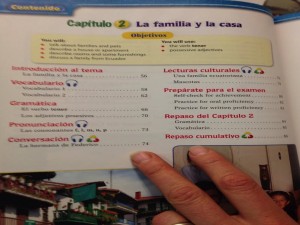
Carino of the state foreign languages teachers association says that Rosetta Stone is the “antithesis” of the new Common Core standards which emphasize critical thinking and analysis. “It’s rote memorization and regurgitation,” he said. He notes that language education is nuanced and requires that students be exposed to the cultural components of a language to provide context. “They are inextricably intertwined,” he said. Carino added that because Rosetta Stone lacks this key element in foreign language education, any school that is using it as its sole curriculum is out of compliance with the New York State syllabus. “Level A of the standards require that students be exposed to cultural awareness and that they engage with their peers in discussions,” he said.
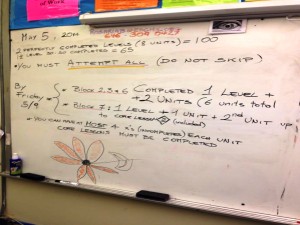
The lack of exposure to foreign culture along with foreign language instruction could hurt students when they start working, said Abbott of foreign languages council. “In many cultures, a lot of business does not get done around the business table, it gets done during side conversations and social situations,” she said. “If you can’t participate in those discussions, you get left out.”
Vicky Li, a junior who has been learning Mandarin and Spanish since January, grew up speaking Mandarin at home. “I’m conversational but I can’t read or write it,” he said. “Rosetta Stone is no help because it uses Pin Yin, the alphabetical way of reading and writing Chinese characters.” Nonetheless Li said Rosetta Stone has helped him speak more fluently. He hopes to minor in Chinese at college. “With a real teacher, hopefully I will be able to learn to read and write Chinese characters,” he said. He plans to stop taking the Mandarin Rosetta Stone course next semester and focus solely on learning Spanish. “Honestly in four months, I haven’t learned much Spanish,” he said. “I really do try though.”
Joseph Richardson, also a junior, sat next to Li. He turned to Li and asked: “¿Qué vas a comer hoy?” Li laughs and said, “I have no idea what he just said.” Richardson, whose parents are from the Dominican Republic, responds shaking his head with a smile, “I just asked ‘What are you going to eat today?’”
Bored to Tears
Students in Bellu’s class are allowed to listen to music while they work. “The program is very repetitive,” Bellu said. “Honestly, it’s boring. So I think music helps them stay focused.” Yet a simple scan around the lab reveals that many students are often not working. Amelie Concepcion, a junior who has been studying Spanish since last year and is currently on Level 3 of Rosetta Stone, sat in the back of the lab next to her friend, Ruben Sanchez, also a junior. “I’m gonna look for a job right now,” she told Sanchez. Concepcion opened the Regal Entertainment Group’s website, and looked for job openings at the nearby movie theater. One student slept through the entire class. Bellu tried to wake her, but she remained face down by her keyboard.
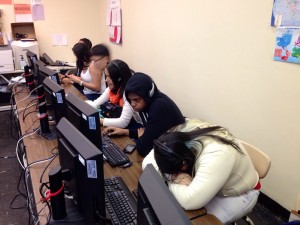
According to Cathy Quenzer, Rosetta Stone’s education director, the program is designed so that students can practice a language at their own pace, using the image-based learning scheme. “They can then come together to share and practice in the classroom,” she said. For the new generation of students, Quenzer notes computer-based learning is not unusual. “We’re dealing with a population that wants to learn differently,” she said. And perhaps this explains the boredom. Rosetta Stone is only supposed to be a tool to help teachers reinforce their lessons. It is not intended to be the sole lesson itself.

Tremoneisha Moore, a senior who has been studying Spanish since last year, and another senior, Kenny Ramirez, were both working on Level 3 of the program and watching an episode of the television show “Marvel’s Agents of S.H.I.E.L.D.,” on Ramirez’s computer. “This class is so boring,” said Ramirez looking up from his computer screen. “If it weren’t for YouTube, I don’t think I could survive it.” Moore agreed. “When you have a real teacher, it’s easier to stay focused because there’s structure,” she said. “They talk to you. You have to answer questions, there are exams and the class discussion just makes you get involved.” Moore said that the Rosetta Stone program is simply a lot of repetition. “Half the time I have no idea what I’m saying,” she said laughing. “The other half I’m feeling good and think I’m a Spanish expert. But really, I don’t know.”


